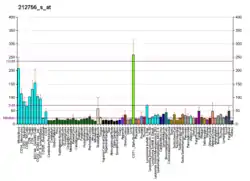UBR2
E3 ubiquitin-protein ligase UBR2 is an enzyme that in humans is encoded by the UBR2 gene.[5]
Proteolysis by the ubiquitin-proteasome system controls the concentration of many regulatory proteins. The selectivity of ubiquitylation is determined by ubiquitin E3 ligases, which recognize the substrate's destabilization signal, or degron. The E3 ligase UBR2 participates in the N-end rule pathway, which targets proteins bearing an N-terminal degron, or N-degron (Kwon et al., 2003).[supplied by OMIM][5]
References
- GRCh38: Ensembl release 89: ENSG00000024048 - Ensembl, May 2017
- GRCm38: Ensembl release 89: ENSMUSG00000023977 - Ensembl, May 2017
- "Human PubMed Reference:". National Center for Biotechnology Information, U.S. National Library of Medicine.
- "Mouse PubMed Reference:". National Center for Biotechnology Information, U.S. National Library of Medicine.
- "Entrez Gene: UBR2 ubiquitin protein ligase E3 component n-recognin 2".
Further reading
- Nagase T, Ishikawa K, Nakajima D, et al. (1997). "Prediction of the coding sequences of unidentified human genes. VII. The complete sequences of 100 new cDNA clones from brain which can code for large proteins in vitro". DNA Res. 4 (2): 141–50. doi:10.1093/dnares/4.2.141. PMID 9205841.
- Strausberg RL, Feingold EA, Grouse LH, et al. (2003). "Generation and initial analysis of more than 15,000 full-length human and mouse cDNA sequences". Proc. Natl. Acad. Sci. U.S.A. 99 (26): 16899–903. Bibcode:2002PNAS...9916899M. doi:10.1073/pnas.242603899. PMC 139241. PMID 12477932.
- Mungall AJ, Palmer SA, Sims SK, et al. (2003). "The DNA sequence and analysis of human chromosome 6". Nature. 425 (6960): 805–11. Bibcode:2003Natur.425..805M. doi:10.1038/nature02055. PMID 14574404.
- Kwon YT, Xia Z, An JY, et al. (2003). "Female Lethality and Apoptosis of Spermatocytes in Mice Lacking the UBR2 Ubiquitin Ligase of the N-End Rule Pathway". Mol. Cell. Biol. 23 (22): 8255–71. doi:10.1128/MCB.23.22.8255-8271.2003. PMC 262401. PMID 14585983.
- Ota T, Suzuki Y, Nishikawa T, et al. (2004). "Complete sequencing and characterization of 21,243 full-length human cDNAs". Nat. Genet. 36 (1): 40–5. doi:10.1038/ng1285. PMID 14702039.
- Yin J, Kwon YT, Varshavsky A, Wang W (2005). "RECQL4, mutated in the Rothmund-Thomson and RAPADILINO syndromes, interacts with ubiquitin ligases UBR1 and UBR2 of the N-end rule pathway". Hum. Mol. Genet. 13 (20): 2421–30. doi:10.1093/hmg/ddh269. PMID 15317757.
- Gerhard DS, Wagner L, Feingold EA, et al. (2004). "The Status, Quality, and Expansion of the NIH Full-Length cDNA Project: The Mammalian Gene Collection (MGC)". Genome Res. 14 (10B): 2121–7. doi:10.1101/gr.2596504. PMC 528928. PMID 15489334.
- Kwak KS, Zhou X, Solomon V, et al. (2005). "Regulation of protein catabolism by muscle-specific and cytokine-inducible ubiquitin ligase E3alpha-II during cancer cachexia". Cancer Res. 64 (22): 8193–8. doi:10.1158/0008-5472.CAN-04-2102. PMID 15548684.
- Zenker M, Mayerle J, Lerch MM, et al. (2006). "Deficiency of UBR1, a ubiquitin ligase of the N-end rule pathway, causes pancreatic dysfunction, malformations and mental retardation (Johanson-Blizzard syndrome)" (PDF). Nat. Genet. 37 (12): 1345–50. doi:10.1038/ng1681. PMID 16311597. S2CID 23050042.
- Matta-Camacho E, Kozlov G, Li F, Gehring K, et al. (2010). "Structural basis of substrate recognition and specificity in the N-end rule pathway". Nat Struct Mol Biol. 17 (10): 1182–7. doi:10.1038/nsmb.1894. PMID 20835242. S2CID 20961853.
External links
This article is issued from Wikipedia. The text is licensed under Creative Commons - Attribution - Sharealike. Additional terms may apply for the media files.






